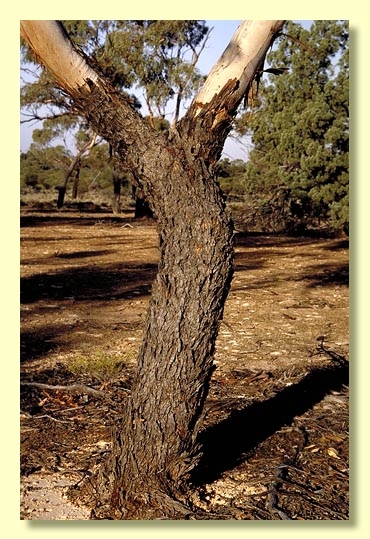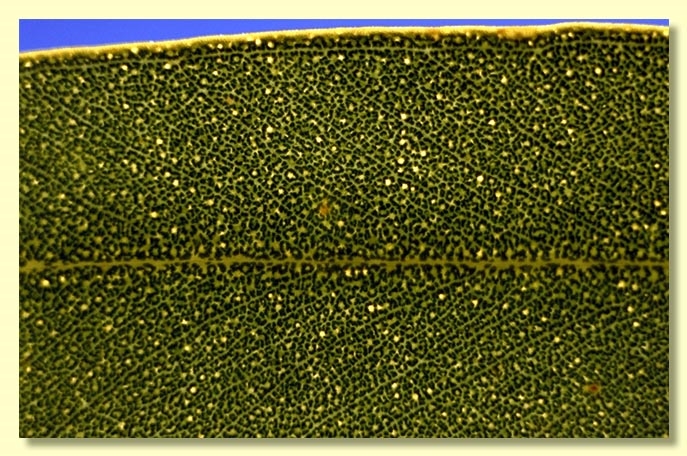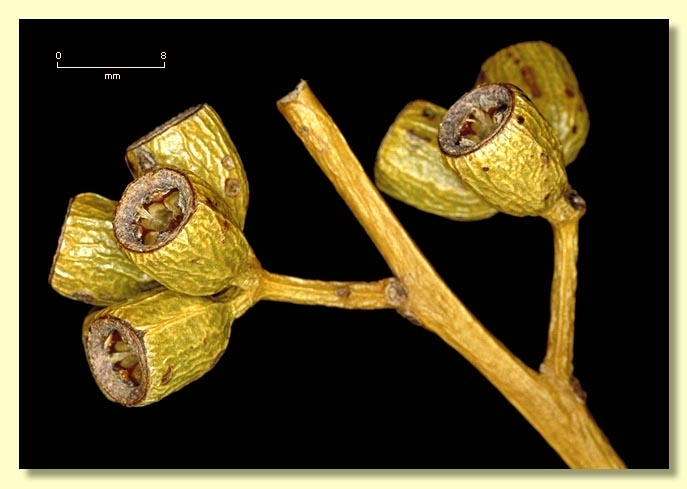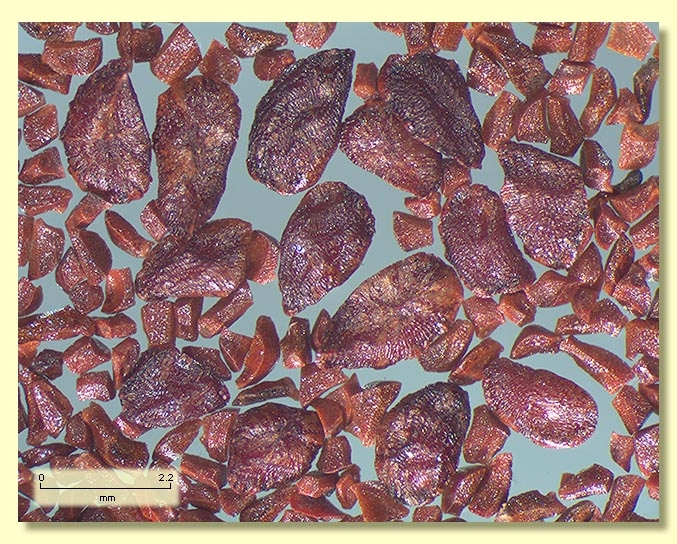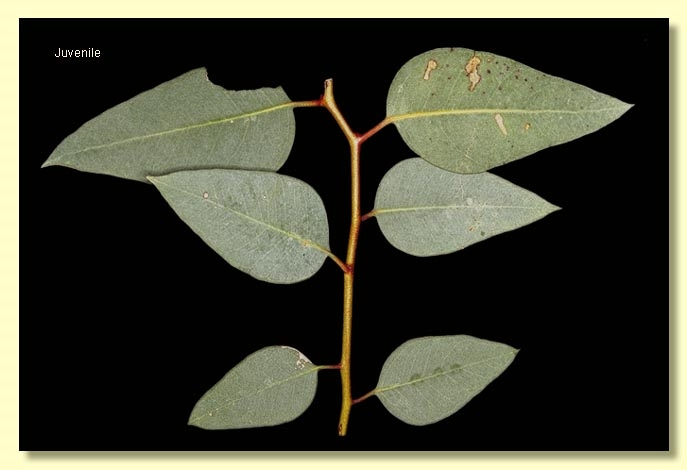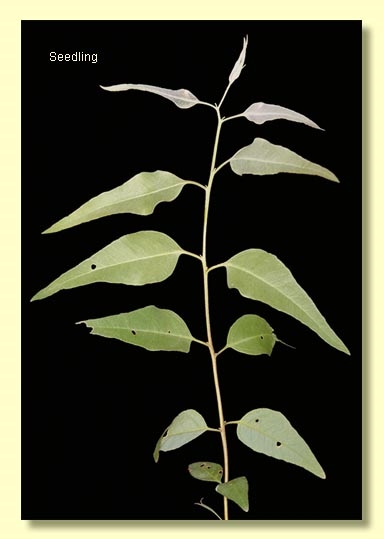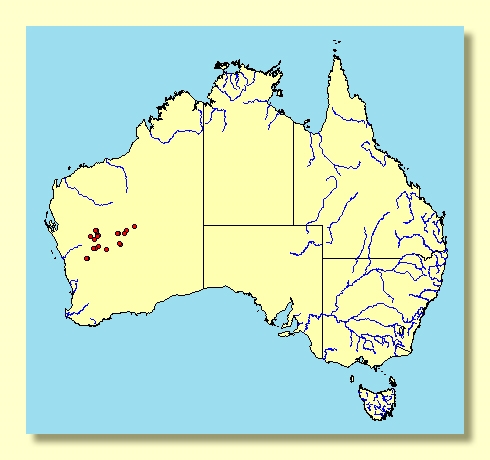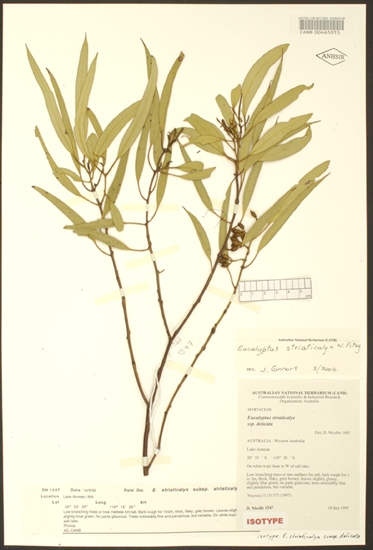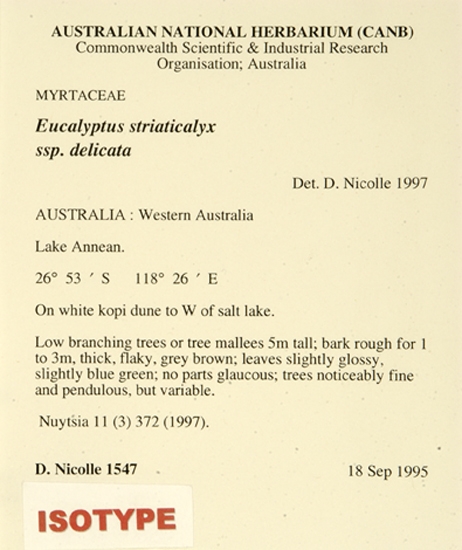Eucalyptus | Symphyomyrtus | Dumaria | Rufispermae
Euclid - Online edition
Eucalyptus striaticalyx
T: Millys Soak, W.A., Sept. 1903, W.V.Fitzgerald s.n.; lecto: PERTH 01394584; isolecto: E, NSW, PERTH 01394592, fide Nicolle, Nuytsia 11: 369 (1997).
Eucalyptus striaticalyx subsp. delicata Nicolle & P.J.Lang, Nuytsia 11: 371 (1997). T: Lake Annean, south of Meekatharra, Western Australia, 26° 53' 59”S, 118° 16' 25”E, 18 Sept. 1995, D.Nicolle 1547; holo: PERTH; iso: CANB.
Bark rough, thick, dark greyish and fibrous over part or all of trunk and sometimes extending to branches ca 5 cm diameter, smooth above creamy brown to pinkish.
Branchlets have oil glands in the pith.
Juvenile growth (coppice or field seedlings to 50 cm): stems square to rounded in cross-section, slightly glaucous; leaves always petiolate, alternate, ovate to broadly lanceolate, 5.5–11 cm long, 2.5–4 cm wide, bluish green.
Adult leaves alternate, petioles 1.3–3 cm long; blade lanceolate to broadly lanceolate, (7)8–15(17.5) cm long, 0.7–2.5 cm wide, base tapering to petiole, margin entire, apex acute, concolorous, dull to slightly glossy, grey-green to blue-green, side-veins at an acute or wider angle to midrib, reticulation dense, intramarginal vein close to margin, oil glands intersectional.
Inflorescence axillary unbranched, peduncles 0.5–1.7 cm long, buds ?7 to 13, pedicellate, pedicels 0.3–0.8 cm long. Mature buds obovoid (0.8–1.3 cm long, 0.4–0.7 cm wide), scar present, operculum as wide as hypanthium, thickly beaked (0.4–0.7 cm long), stamens inflexed, cuboid to wedge shaped versatile anthers, sub-basifixed, dehiscing by longitudinal slits, style long and straight, stigma blunt to rounded, locules 4, the placentae each with 4 vertical rows of ovules. Flowers white.
Fruit pedicellate, pedicels 0.2–0.5 cm long, obconical to cupular, 0.6–1 cm long, 0.5–0.9 cm wide, disc descending, valves 4, about rim level.
Seeds reddish brown and glossy, 1.5–3 mm long, flattened-ovoid and often angular in outline, dorsal surface shallowly reticulate, hilum ventral.
Cultivated seedlings (measured at node 10): cotyledons reniform; stems square in cross-section, non-glaucous or slightly glaucous; leaves always petiolate, opposite for 3 to 6 nodes (rarely more) then alternate, lanceolate, 6–11.5 cm long, 1.5–4(5.5) cm wide, dull, green, shoot apex may be slightly glaucous but wax soon lost as leaves expand.
Flowering has been recorded in January.
A small tree endemic to Western Australia distributed discontinuously in the northern goldfields, from north-west of Meekatharra south-west towards Mongers Lake and north-east to Lake Carnegie, with a disjunct occurrence at Lake Minigwal, north-east of Kalgoorlie. It is found around salt lakes and low drainage lines in flat country on powdery loams over limy subsoil. The bark is rough often extending to the middle-sized branches and the adult leaves dull to slightly glossy.
In the classification of Brooker (2000) Eucalyptus striaticalyx belongs in Eucalyptus subgenus Symphyomyrtus section Dumaria having these features: buds initially with two opercula the outer shed early, stamens strongly inflexed, ovules in 4 rows on the placentae and cotyledons reniform. Within section Dumaria the species belongs to a large sub-group of closely related species (series Rufispermae, 37 described species and subspecies) diagnosed by glandular pith in the branchlets, cuboid to wedge shaped versatile anthers, and by the reddish brown and glossy, flattish seeds which are unique to the series.
The extensive rough bark of E. striaticalyx distinguishes it from all other tree species in the series Rufispermae except E. kondininensiswhich has much smaller buds and fruit and occurs well to the south. The closely related E. gypsophila from the Great Victoria Desert and sporadically west to Tallering Peak and the country south-east of the Pilbara, and E. repullulans from the Pilbara and Wingellina, both differ from E. striaticalyx in being mallees.
E. striaticalyx subsp. delicata was described in 1997 from the restricted environs of Lake Annean and Lake Austin, north and south of Cue, Western Australia. It has a more depauperate form with narrower leaves and pendulous branchlets and occurs on gypseous substrates around salt lakes. It is not recognised in this edition of EUCLID as being distinct.


